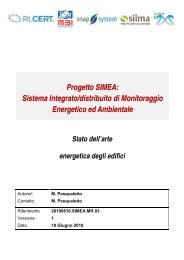Stato dell'arte energetica degli edifici - Automatica - Università degli ...
Stato dell'arte energetica degli edifici - Automatica - Università degli ...
Stato dell'arte energetica degli edifici - Automatica - Università degli ...
You also want an ePaper? Increase the reach of your titles
YUMPU automatically turns print PDFs into web optimized ePapers that Google loves.
SIMEA <strong>Stato</strong> dell’arte <strong>energetica</strong> <strong>degli</strong> <strong>edifici</strong><br />
1.2.23. Energy-10<br />
46<br />
Doc.No 20100610.SIMEA.MR.03<br />
Versione 1<br />
Energy-10 is a user-friendly early design stage building energy<br />
simulation program that integrates daylighting, passive solar heating, and<br />
low-energy cooling strategies with energy-efficient shell design and<br />
mechanical equipment. The program is geared toward small commercial and<br />
residential buildings of 10,000 ft 2 or less-that's where the "10" in Energy-10<br />
comes from. Developed by the U.S. Department of Energy since 1992,<br />
Energy-10 runs an hourly thermal network simulation while allowing users to<br />
rapidly explore a wide range of energy efficiency strategies and plot the results in a number of ways.<br />
Energy-10 takes a baseline simulation and automatically applies a number of predefined strategies<br />
ranging from building envelope (insulation, glazing, shading, thermal mass, etc.) and system efficiency<br />
options (HVAC, lighting, daylighting, solar service hot water and integrated photovoltaic electricity<br />
generation). Full life-cycle costing is an integral part of the software. Starting from building location,<br />
footprint, usage type and HVAC type Energy-10 can generate reference and low-energy target cases in<br />
seconds based on full annual hourly simulation. Ranking graphs for individual strategies can guide early<br />
design analysis. Built-in graphs including an embedded version of "DVIEW" allow flexible review of<br />
summary and hourly results. Energy-10 can be used to evaluate and select strategies for much larger<br />
buildings. Insulation levels, daylighting, glazing, shading, and passive solar strategies can be calculated<br />
under the assumption that a large building is kept at a reasonably uniform temperature. However, overall<br />
energy use may be underestimated because HVAC interactions between multiple zones may not be<br />
accurately represented. Energy-10 allows rapid exploration of broad design issues effecting energy<br />
performance early in design based on a BESTEST (ASHRAE Standard 140- 2001) validated thermal<br />
simulation engine.<br />
1.2.23.1. Expertise Required<br />
Moderate level of computer literacy required; two days of training advised.<br />
1.2.23.2. Users<br />
More than 3,200 users worldwide.<br />
1.2.23.3. Audience<br />
Building designers, especially architects; also HVAC engineers, utility companies, university schools<br />
of architecture and architectural engineering.<br />
1.2.23.4. Input<br />
Only 4 inputs required to generate two initial generic building descriptions. Virtually everything is<br />
defaulted but modifiable. User adjusts descriptions as the design evolves, using fill-in menus, including<br />
utility-rate schedules, construction details, materials.<br />
1.2.23.5. Output<br />
Summary table and 20 graphical outputs available, generally comparing current design with base case.<br />
Detailed tabular results also available.
















